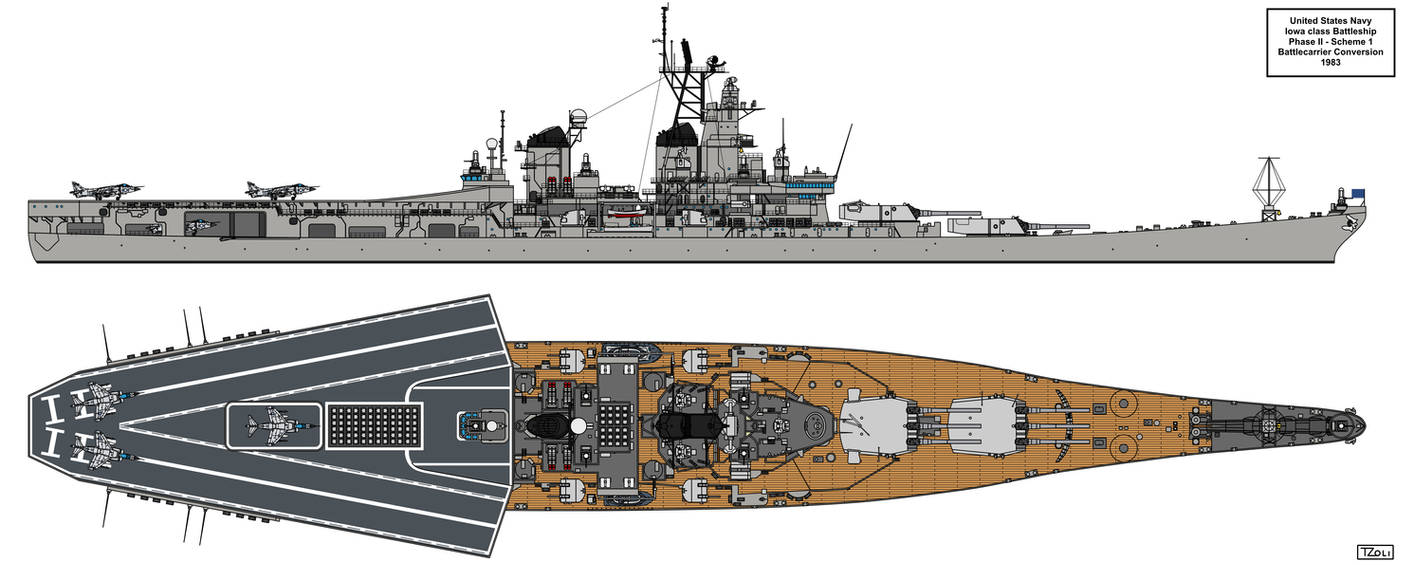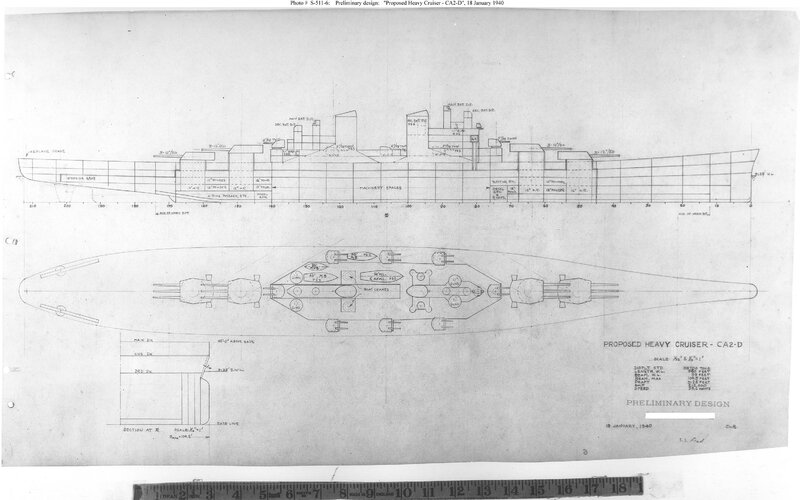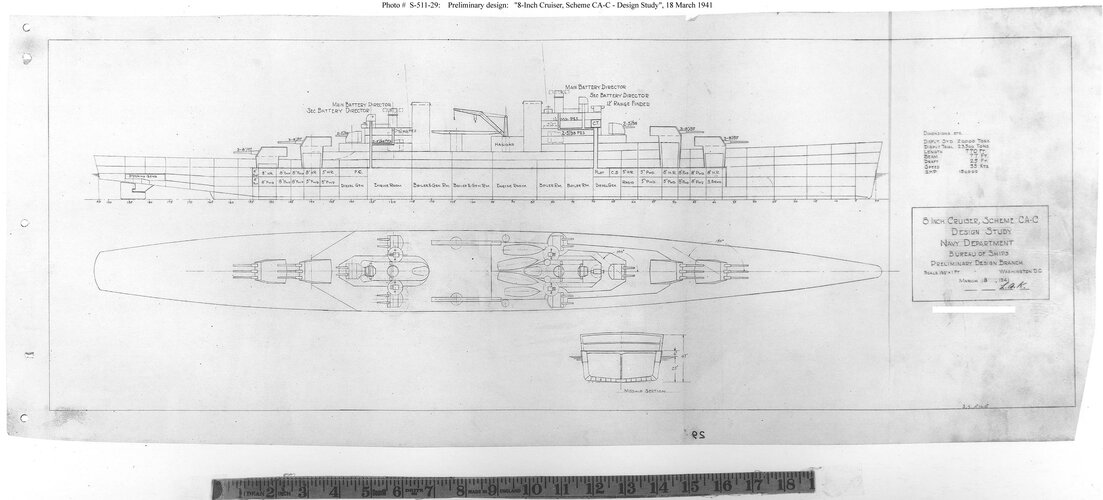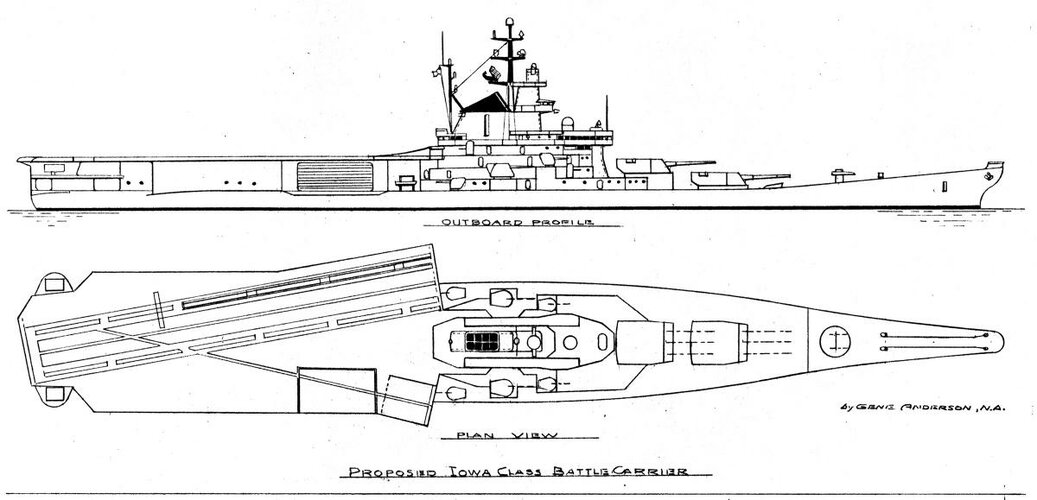so to much of a PITA and to costly to fix... lets just call it "of historical importance" you know like a coat of paint over the truth so we don't look cheap or lazy LOLWould have required cutting into the belt armor. It was left at the end of WW2 when there was no intention to use Mo as a museum ship. It was left in the 1960s reactivation. It was left in the 1980s reactivation.
You are using an out of date browser. It may not display this or other websites correctly.
You should upgrade or use an alternative browser.
You should upgrade or use an alternative browser.
Iowa and Alaska Class Conversion Projects
- Thread starter Triton
- Start date
Scott Kenny
ACCESS: USAP
- Joined
- 15 May 2023
- Messages
- 11,628
- Reaction score
- 14,305
Navy's not afraid to say, "not causing operational issues, and too expensive to fix since it's not causing operational issues"so to much of a PITA and to costly to fix... lets just call it "of historical importance" you know like a coat of paint over the truth so we don't look cheap or lazy LOL
- Joined
- 6 September 2006
- Messages
- 4,833
- Reaction score
- 9,452
Off topic discussion on aircraft carriers moved here: https://www.secretprojects.co.uk/threads/aircraft-carrier-hangar-design-discussion.42009/
There is an artwork of one of the Iowas preparred to launch a satellite as well as a carrier I think an Essex:
Ticonderoga subclass eg longhull Essex conversion:
Found one gem of a document on Google books.
Attachments
that_person
ACCESS: Secret
- Joined
- 25 May 2021
- Messages
- 339
- Reaction score
- 650
Awesome find!Found one gem of a document on Google books.
Kat Tsun
eeeeeeeeeeeeeee
- Joined
- 16 June 2013
- Messages
- 1,371
- Reaction score
- 1,778
so to much of a PITA and to costly to fix... lets just call it "of historical importance" you know like a coat of paint over the truth so we don't look cheap or lazy LOL
There's nothing cheap or lazy about not fixing something that isn't broken...
I would think that my making a joke here was obviousThere's nothing cheap or lazy about not fixing something that isn't broken...
F.L.
ACCESS: Top Secret
Scott Kenny
ACCESS: USAP
- Joined
- 15 May 2023
- Messages
- 11,628
- Reaction score
- 14,305
Wow that's an intensive rebuild... Added a whole Mk26 up forward, replaced 4x 5"38s with 5"/54s and replaced 2x 5"/38s with 8"/55s?It's my favourite project of Iowa-class conversion. Designed to operate F/A-18s and Harriers.
With a cat and a skyjump. Plus arresting cables.
View attachment 710306
that_person
ACCESS: Secret
- Joined
- 25 May 2021
- Messages
- 339
- Reaction score
- 650
Just about nothing in this drawing is actually feasibleIt's my favourite project of Iowa-class conversion. Designed to operate F/A-18s and Harriers.
With a cat and a skyjump. Plus arresting cables.
View attachment 710306
Dilandu
I'm dissatisfied, which means, I exist.
While it may be remotely possible to safely catapult F/A-18 from such arrangement, it would be next thing to impossible to land it. Not only the deck is very short, but superstructure would disturb air over deck very seriously. Also, making aircraft elevator part of runaway for Harriers isn't a good idea; it would be subjected to hot engine excaust.It's my favourite project of Iowa-class conversion. Designed to operate F/A-18s and Harriers.
With a cat and a skyjump. Plus arresting cables.
Mk-26 launcher in ftont of main turrets would almost certainly not survive the shockwaves from gun blasts. At very least, some kind of protective dome (collapsible) would be needed. Or "disappearing" launcher, that could be retracted below deck.
Also, there are no radar illuminators on the scheme, so the only thing it could launch is ASROC.
And I utterly fail to see why a battleship may need a 8-inch guns on broadside.
- Joined
- 6 September 2006
- Messages
- 4,833
- Reaction score
- 9,452
Ditto that for just about every hybrid Iowa concept ever made!Just about nothing in this drawing is actually feasible
F.L.
ACCESS: Top Secret
This was envisaged in view of the problems encountered by the Japanese Ise class battlecarriers.but superstructure would disturb air over deck very seriously.
To reduce superstructure wind turbulence, I suggest leaving the tower as it is with its range finder and smooth sides and removing the after stack. Duct this stack’s boiler uptakes forward to one large streamlined funnel similar to that found on the South Dakota (BB-57)-class battleships. As noted on the drawing, also remove any other unnecessary air turbulence-forming clutters on the sides of the main superstructure. A wind tunnel smoke test would be helpful here using various model configurations of the Iowas to determine the best wind flow over the superstructure.
Source : https://www.usni.org/magazines/proceedings/1981/july/comment-and-discussion
This was partly the case on the three Illustrious and HMS Hermes.Also, making aircraft elevator part of runaway for Harriers isn't a good idea; it would be subjected to hot engine excaust.

- Joined
- 1 February 2011
- Messages
- 2,938
- Reaction score
- 3,623
Not to mention the model shown is just a plain Iowa model modified. Look at the WW2 era Boforses, and the aft 5" director behind and above the VLS cells, with a Phalanx in place of the aft main gun director. (Though that shows the Martin Marietta's proposal)
Indeed 5"/54 and 8"/55 mix are not worth it.
Either the artist misinterpreted what Gene Anderson was proposing or Gene Anderson did not know what he was proposing for the New Jersey (If I remember correctly only New Jersey was considered for the Scheme 1 BBV conversion)
The other two, Harold Pulver's and Marin Marietta's proposals were much better.
Martin Marietta:

 www.deviantart.com
www.deviantart.com
Harold Pulver:
Though it would be nice to get hold of the very original documents describing or even sketching up these proposals
Indeed 5"/54 and 8"/55 mix are not worth it.
Either the artist misinterpreted what Gene Anderson was proposing or Gene Anderson did not know what he was proposing for the New Jersey (If I remember correctly only New Jersey was considered for the Scheme 1 BBV conversion)
The other two, Harold Pulver's and Marin Marietta's proposals were much better.
Martin Marietta:

Iowa Phase II Battlecarrier Conversion by Tzoli on DeviantArt
Harold Pulver:
Though it would be nice to get hold of the very original documents describing or even sketching up these proposals
Dilandu
I'm dissatisfied, which means, I exist.
Only partially, and they were relatively far from ski-jump, not almost directly in front of it.This was partly the case on the three Illustrious and HMS Hermes.
Scott Kenny
ACCESS: USAP
- Joined
- 15 May 2023
- Messages
- 11,628
- Reaction score
- 14,305
CIWS all the way forward on the bow is not in a good spot, boss. Gonna be wave-swept for sure.
Iowa Phase II Battlecarrier Conversion by Tzoli on DeviantArt
www.deviantart.com
- Joined
- 1 February 2011
- Messages
- 2,938
- Reaction score
- 3,623
Did you seen the height of the nose of an Iowa? The Phalanx is even higher and also the WW2 era Oerlikon bulwark is there as well.CIWS all the way forward on the bow is not in a good spot, boss. Gonna be wave-swept for sure.
But I see your point:
Dilandu
I'm dissatisfied, which means, I exist.
Would Phalanx on the bow survive the main battery fire on forward angles?Did you seen the height of the nose of an Iowa? The Phalanx is even higher and also the WW2 era Oerlikon bulwark is there as well.
But I see your point:
P.S. Also, I'm not sure that retaining the rear pair of 5-inch turrets is practical. The fly deck angles basically block a significant part of their fire arcs.
- Joined
- 1 February 2011
- Messages
- 2,938
- Reaction score
- 3,623
Think. How close have to be the enemy ship for the guns to fire at such low angles?Would Phalanx on the bow survive the main battery fire on forward angles?
P.S. Also, I'm not sure that retaining the rear pair of 5-inch turrets is practical. The fly deck angles basically block a significant part of their fire arcs.
Broadside fire was the expected coastal bombardment for both the 16" and 5" guns.
Dilandu
I'm dissatisfied, which means, I exist.
A point. Frankly, I suspect that the probability of Iowa's using main guns on enemy ships in 1980s was considered far too low to bother.Think. How close have to be the enemy ship for the guns to fire at such low angles?
pathology_doc
ACCESS: Top Secret
- Joined
- 6 June 2008
- Messages
- 1,587
- Reaction score
- 1,507
On that note, I'd like to know what's been done with the museum ship HMS Warrior with respect to hull preservation. That thing has been around since 1860.When you have a ship approaching a century old, it's going to happen.
Scott Kenny
ACCESS: USAP
- Joined
- 15 May 2023
- Messages
- 11,628
- Reaction score
- 14,305
If they can keep it from rusting, it works out to thick layers of paint over original metals. But I suspect that the hull plating has been replaced by this time.On that note, I'd like to know what's been done with the museum ship HMS Warrior with respect to hull preservation. That thing has been around since 1860.
As to the USS Constitution, there's almost no wood left from her original construction, it's all been replaced but for a few chunks of keel.
T. A. Gardner
ACCESS: Top Secret
- Joined
- 18 February 2021
- Messages
- 1,151
- Reaction score
- 2,021
Well, according to Lambert's HMS Warrior 1860 Victoria's Ironclad Deterrent, the main deck was sealed below the wood surface that shows with an ICI product akin to what's called "Flex Seal" in the US.On that note, I'd like to know what's been done with the museum ship HMS Warrior with respect to hull preservation. That thing has been around since 1860.

Flex Seal Family of Products | The Official Store
The easy way to patch, bond, seal and stop leaks fast. Featuring our full line of Flex Seal Products.
This is a liquid rubber-like compound that forms a watertight barrier between the iron deck underneath it and the wood above to prevent rain leaking into the ship and rotting it out from the inside. The hull was cleaned and--I assume--painted with a modern two-part epoxy marine paint that will last decades as a barrier to corrosion of the hull. Most of the original hull was found to be intact to an extent that it didn't need replacement interestingly enough.
Badly corroded iron parts were replaced with steel and welding was used in some areas rather than riveting. Note: You can weld steel plate to wrought iron using special welding rod...
- Joined
- 19 July 2016
- Messages
- 4,275
- Reaction score
- 3,459
On the OT, while it is interesting as an exercise, Shirley the cost would remove any possiblity to proceed to cutting steel. Might even have been cheaper to convert them to nuclear power and use the for the BG command ship they actually performed for a while.
Scott Kenny
ACCESS: USAP
- Joined
- 15 May 2023
- Messages
- 11,628
- Reaction score
- 14,305
That surprises the hell out of me.Well, according to Lambert's HMS Warrior 1860 Victoria's Ironclad Deterrent, the main deck was sealed below the wood surface that shows with an ICI product akin to what's called "Flex Seal" in the US.

Flex Seal Family of Products | The Official Store
The easy way to patch, bond, seal and stop leaks fast. Featuring our full line of Flex Seal Products.flexsealproducts.com
This is a liquid rubber-like compound that forms a watertight barrier between the iron deck underneath it and the wood above to prevent rain leaking into the ship and rotting it out from the inside. The hull was cleaned and--I assume--painted with a modern two-part epoxy marine paint that will last decades as a barrier to corrosion of the hull. Most of the original hull was found to be intact to an extent that it didn't need replacement interestingly enough.
Ironically, large steel riveting is just about forgotten as a technique these days.Badly corroded iron parts were replaced with steel and welding was used in some areas rather than riveting. Note: You can weld steel plate to wrought iron using special welding rod...
Not a great loss in general, but for historically significant items it's a bit of a shame.
Scott Kenny
ACCESS: USAP
- Joined
- 15 May 2023
- Messages
- 11,628
- Reaction score
- 14,305
I'd assume that they laid down some epoxy paint before the flex seal.Flex seal on metal is double edged sword. It is not an air barrier so some vapor goes through. It will condense on the metal and when it does it acts hydraulic.
T. A. Gardner
ACCESS: Top Secret
- Joined
- 18 February 2021
- Messages
- 1,151
- Reaction score
- 2,021
That source I mentioned earlier cited that the iron main deck was 3/4" thick so I can see that surviving. I suspect the hull was likewise simply thick enough material that it didn't all rot away. Lambert did mention that rainwater and humidity had been bad enough to let stalactites to form as over the years a large number of concrete patches were applied to the main deck.
It seems the restoration when for appearance and durability ahead of historical accuracy for both cost reasons and the inability to source many of the materials and methods used originally.
It seems the restoration when for appearance and durability ahead of historical accuracy for both cost reasons and the inability to source many of the materials and methods used originally.
Scott Kenny
ACCESS: USAP
- Joined
- 15 May 2023
- Messages
- 11,628
- Reaction score
- 14,305
I'm okay with that.That source I mentioned earlier cited that the iron main deck was 3/4" thick so I can see that surviving. I suspect the hull was likewise simply thick enough material that it didn't all rot away. Lambert did mention that rainwater and humidity had been bad enough to let stalactites to form as over the years a large number of concrete patches were applied to the main deck.
It seems the restoration when for appearance and durability ahead of historical accuracy for both cost reasons and the inability to source many of the materials and methods used originally.
Yes, obviously original materials types and methods are best, but when that's unreasonably expensive you do the preservation for appearance and durability then call it as good as you can get.
BlackBat242
OK, I changed my personal text ;)
- Joined
- 10 April 2013
- Messages
- 1,474
- Reaction score
- 4,281
Yes... the interior structural/armor design was that of a scaled-up heavy cruiser hull, not a scaled-down battleship hull.Alaska was considered a “Large Cruiser”—a step up from Heavy Cruiser?
The secondary (dual-purpose 5") battery was the same as that on the USN's heavy cruisers as well. Had the design been a scaled-down battleship one there would have been another pair of 5"/38 twin mounts on the sides instead of the aircraft catapults, with the catapults being mounted aft.
SSgtC
ACCESS: Top Secret
- Joined
- 13 July 2020
- Messages
- 1,241
- Reaction score
- 2,890
Alaska was considered a “Large Cruiser”—a step up from Heavy Cruiser?
AIUI, the Alaska class were basically what heavy cruisers would have been without the Washington and London Naval Treaties artificially limiting cruisers to 10,000 tons and 8" guns.Yes... the interior structural/armor design was that of a scaled-up heavy cruiser hull, not a scaled-down battleship hull.
The secondary (dual-purpose 5") battery was the same as that on the USN's heavy cruisers as well. Had the design been a scaled-down battleship one there would have been another pair of 5"/38 twin mounts on the sides instead of the aircraft catapults, with the catapults being mounted aft.
AIUI, the Alaska class were basically what heavy cruisers would have been without the Washington and London Naval Treaties artificially limiting cruisers to 10,000 tons and 8" guns.
12 000 tons cruisers, 36 000 tons battleships
15 000 tons cruisers, 45 000 tons battleships
25 000 tons cruisers, 75 000 tons battleships
pathology_doc
ACCESS: Top Secret
- Joined
- 6 June 2008
- Messages
- 1,587
- Reaction score
- 1,507
Interesting! Thank you.Well, according to Lambert's HMS Warrior 1860 Victoria's Ironclad Deterrent, the main deck was sealed below the wood surface that shows with an ICI product akin to what's called "Flex Seal" in the US.

Flex Seal Family of Products | The Official Store
The easy way to patch, bond, seal and stop leaks fast. Featuring our full line of Flex Seal Products.flexsealproducts.com
This is a liquid rubber-like compound that forms a watertight barrier between the iron deck underneath it and the wood above to prevent rain leaking into the ship and rotting it out from the inside. The hull was cleaned and--I assume--painted with a modern two-part epoxy marine paint that will last decades as a barrier to corrosion of the hull. Most of the original hull was found to be intact to an extent that it didn't need replacement interestingly enough.
Badly corroded iron parts were replaced with steel and welding was used in some areas rather than riveting. Note: You can weld steel plate to wrought iron using special welding rod...
Scott Kenny
ACCESS: USAP
- Joined
- 15 May 2023
- Messages
- 11,628
- Reaction score
- 14,305
Maybe a bit bigger than that, they were designed to go hunting whatever super cruisers the Japanese made. Hence why they weren't named for cities or for states, but territories.AIUI, the Alaska class were basically what heavy cruisers would have been without the Washington and London Naval Treaties artificially limiting cruisers to 10,000 tons and 8" guns.
Scott Kenny
ACCESS: USAP
- Joined
- 15 May 2023
- Messages
- 11,628
- Reaction score
- 14,305
The 25kton cruisers were the Des Moines class, though.12 000 tons cruisers, 36 000 tons battleships
15 000 tons cruisers, 45 000 tons battleships
25 000 tons cruisers, 75 000 tons battleships
Alaska class was 35ktons!
BlackBat242
OK, I changed my personal text ;)
- Joined
- 10 April 2013
- Messages
- 1,474
- Reaction score
- 4,281
Baltimore/Oregon City classes: 13,600 long tons (13,818 t) standard; 17,000 long tons (17,273 t) full loadThe 25kton cruisers were the Des Moines class, though.
Alaska class was 35ktons!
Des Moines class: 17,255 long tons (17,532 t) standard; 20,933 long tons (21,269 t) full load
Alaska class: 29,771 long tons (30,249 t) standard; 34,253 long tons (34,803 t) full load
The treaties all used standard tons, so the Baltimores were 13,500 ton ships, Des Moines was a 17,000 ton ship and the Alaska was a 30,000 ton ship.
The North Carolinas/South Dakotas were the 36,000 ton ships, and the Iowas were the 45,000 ton ships.
A Tentative Fleet Plan
I really should change my personal text
- Joined
- 9 April 2018
- Messages
- 1,212
- Reaction score
- 2,833
Design CA2-D of the Alaska preliminary designs displaced 37,800 tons, but at that point it very much at the Battleship end of the scale, with thicker belt armour than an Iowa, the machinery of an Iowa, and a Battleship-style sandwich underwater protection system.

The closest a heavy cruiser got to 20,000 tons (aside from Alaska preliminaries), was the Treaty unlimited design CA-C, which was intended to be protected against super-heavy 8-inch shells, have a speed of 35 knots.


The closest a heavy cruiser got to 20,000 tons (aside from Alaska preliminaries), was the Treaty unlimited design CA-C, which was intended to be protected against super-heavy 8-inch shells, have a speed of 35 knots.

Similar threads
-
-
-
Postwar Royal Navy Battleships? (NOT including the Vanguard!)
- Started by Blacktail
- Replies: 81
-
-

